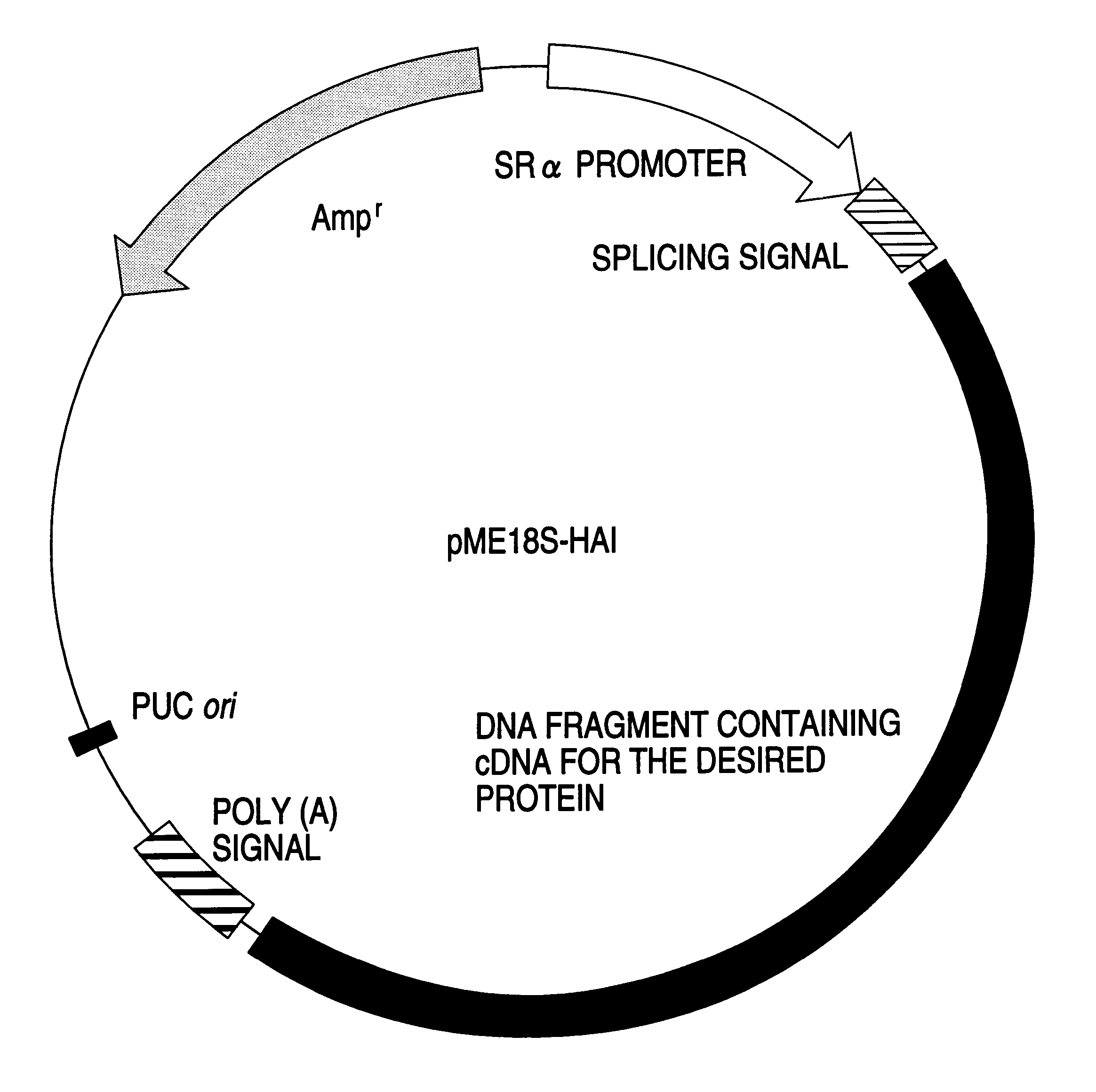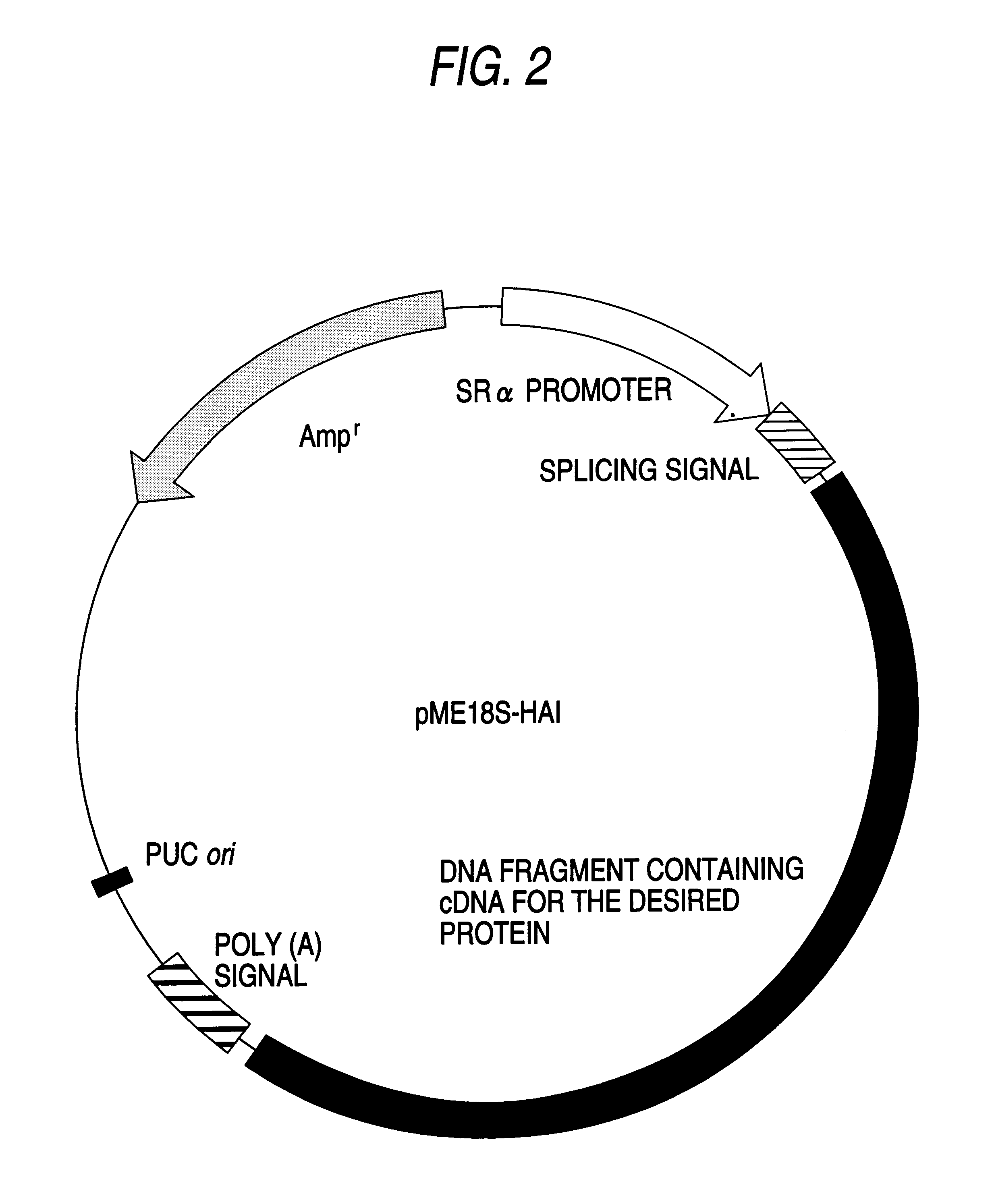Protein, DNA coding for same and method of producing the protein
a technology of dna coding and protein, applied in the field of new protein and dna coding for the same, can solve the problems of labor, time and cost, and the method is not always the best, and achieve the effect of stably isolating the minor amount of hai-i alon
- Summary
- Abstract
- Description
- Claims
- Application Information
AI Technical Summary
Benefits of technology
Problems solved by technology
Method used
Image
Examples
example 1
(Purification of the Protein Using an MKN45 Cell Culture Supernatant)
MKN45 cells (Naito et al., Gan to Kagaku-ryoho (Cancer and Chemotherapy), 5, 89 (1978)) (obtained from Meneki Seibutsu Kenkyusho) were seeded into eRDF medium containing 5% FBS (fetal bovine serum) as placed in a roller bottle 850 and allowed to multiplicate until a confluent state was attained. Then, the FBS-containing culture supernatants were removed and the cells were washed with two portions of serum-free eRDF medium. After removing the washing medium, 500 ml of serum-free eRDF medium was added and incubation was carried out at 37.degree. C. for 3 to 6 days. After incubation, the culture supernatants were recovered, 500 ml of fresh serum-free eRDF medium was added, and incubation was again conducted. This procedure was repeated several times. The culture supernatants thus recovered were combined and concentrated about 20-fold using a YM30 ultrafiltration membrane (Amicon).
This concentrate was submitted to a he...
example 2
(Amino-terminal Amino Acid Sequence and Partial Amino Acid Sequence Determination of the Protein)
The protein having protease inhibitor activity as purified as in Example 1 and eluted by reversed phase HPLC was dried under reduced pressure without neutralization. This was dissolved in 60 .mu.l of 50% TFA (trifluoroacetic acid), added to a polybrene-treated glass filter and subjected to Edman degradation on an Applied Biosystems model 470A sequencer, and the amino acid sequence of an N-terminal region was determined. Phenylhydantoin (PTH)-amino acids were identified using a Mitsubishi Chemical's MCI gel ODS IHU column (0.46.times.15 cm) and conducting single solvent elution with acetate buffer (10 mM acetate buffer (pH 4.7), 0.01% SDS, 38% acetonitrile) at a flow rate of 1.2 ml / minute and a temperature of 43.degree. C. PTH-amino acids were detected based on the absorbance at 269 nm.
As a result, the N-terminal amino acid sequence shown below in Table 1 was identified.
Then, the same pro...
example 3
(Purification of the Protein Using an A549 Cell Culture Supernatant and Amino Acid Sequence Analysis)
A culture supernatant was prepared by cultivating A549 cells (obtained from the Japanese Cancer Research Resources Bank) in the same manner as in Example 1. Using the culture supernatant and proceeding in the same manner as in Example 1, a protein having the inhibitory activity on the protease activity of HGF activator was obtained. Upon SDS-PAGE, this protein showed the same molecular weight as that derived from MKN45 cells. When subjected to the same N-terminal amino acid sequence determination as in Example 1, this protein gave the same sequence as that of the MKN45 cell-derived protein. This suggested the possibility of the protein being identical with the MKN45-derived protein.
PUM
| Property | Measurement | Unit |
|---|---|---|
| Mass | aaaaa | aaaaa |
| Chemical properties | aaaaa | aaaaa |
| Molecular weight | aaaaa | aaaaa |
Abstract
Description
Claims
Application Information
 Login to View More
Login to View More - R&D
- Intellectual Property
- Life Sciences
- Materials
- Tech Scout
- Unparalleled Data Quality
- Higher Quality Content
- 60% Fewer Hallucinations
Browse by: Latest US Patents, China's latest patents, Technical Efficacy Thesaurus, Application Domain, Technology Topic, Popular Technical Reports.
© 2025 PatSnap. All rights reserved.Legal|Privacy policy|Modern Slavery Act Transparency Statement|Sitemap|About US| Contact US: help@patsnap.com



